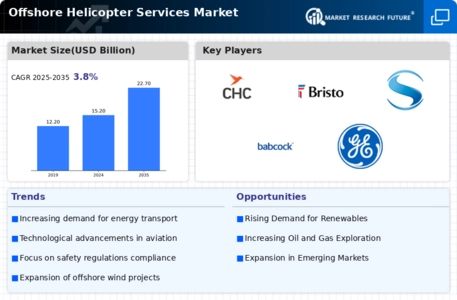Expansion of Renewable Energy Projects
The Offshore Helicopter Services Market is witnessing growth driven by the expansion of renewable energy projects, particularly offshore wind farms. As countries strive to meet renewable energy targets, the development of offshore wind energy has gained momentum. Helicopters are essential for transporting personnel and equipment to these remote sites, ensuring the smooth operation and maintenance of wind turbines. In 2025, the offshore wind sector is projected to see substantial investments, further increasing the demand for helicopter services. This trend not only supports the Offshore Helicopter Services Market but also aligns with global sustainability goals, making it a pivotal area for future growth.
Increasing Offshore Oil and Gas Exploration
The Offshore Helicopter Services Market is experiencing a surge in demand due to the increasing exploration activities in offshore oil and gas fields. As energy companies seek to tap into untapped reserves, the need for efficient transportation of personnel and equipment to remote locations becomes paramount. In 2025, it is estimated that offshore oil production will account for a significant portion of total global oil output, necessitating reliable helicopter services. This trend is further supported by advancements in drilling technologies, which allow for deeper and more complex offshore operations. Consequently, the Offshore Helicopter Services Market is poised for growth as operators expand their fleets to meet the rising demand for safe and timely transportation in challenging environments.
Technological Innovations in Helicopter Design
Technological advancements in helicopter design and manufacturing are playing a crucial role in shaping the Offshore Helicopter Services Market. Innovations such as improved fuel efficiency, enhanced safety features, and advanced navigation systems are making helicopters more reliable and cost-effective for offshore operations. For instance, the introduction of composite materials has led to lighter and more durable aircraft, which can operate in harsher conditions. Furthermore, the integration of digital technologies, including real-time tracking and predictive maintenance, enhances operational efficiency. As these technologies continue to evolve, they are likely to attract more operators to the Offshore Helicopter Services Market, thereby expanding the overall market size and improving service delivery.
Rising Safety Standards and Regulatory Compliance
The Offshore Helicopter Services Market is significantly influenced by the increasing emphasis on safety standards and regulatory compliance. Governments and regulatory bodies are implementing stringent safety regulations to ensure the well-being of personnel working in offshore environments. This has led to a heightened demand for helicopter services that adhere to these regulations, prompting operators to invest in modern fleets and training programs. In 2025, it is anticipated that compliance with international safety standards will be a key differentiator among service providers. As a result, companies that prioritize safety and regulatory adherence are likely to gain a competitive edge in the Offshore Helicopter Services Market, fostering trust and reliability among clients.
Increased Investment in Infrastructure Development
The Offshore Helicopter Services Market is benefiting from increased investment in infrastructure development, particularly in coastal regions. Governments and private entities are allocating substantial resources to enhance port facilities, helipads, and support services for offshore operations. This investment is crucial for improving accessibility and operational efficiency, thereby attracting more companies to utilize helicopter services for their offshore projects. In 2025, it is expected that infrastructure improvements will facilitate smoother logistics and reduce operational delays, further driving the demand for helicopter services. As infrastructure continues to develop, the Offshore Helicopter Services Market is likely to experience sustained growth, providing essential support to various sectors.

















Leave a Comment